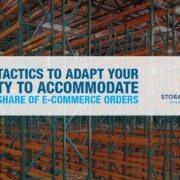For the uninitiated, forward pick areas can be among the most impactful storage solutions for warehouses and fulfillment centers stuck in what we call “day one” simple pick processes. These warehouses have products in static storage configurations throughout the warehouse and an area for packing and shipping. When an order comes in, a worker physically walks to select the products and walks them over to the shipping or packing area.
It sounds simplistic, but this is an inefficient process for most operations and is the lowest level of picking that one could execute. When we hear companies say they are picking from floor-level positions to pallets or carts, we tell them they are probably going about their processes incorrectly.
Why? Because in an environment rife with labor challenges, an increasing volume of orders, and increasing operational costs, forward pick areas can offer solutions to the challenges warehouses are facing today. Without a forward pick area, workers must pick each product from the main storage area, and transporting it to packing is an inherently expensive process.
Instead, by using a forward pick area, popular products are temporarily stored in a storage medium like shelving bins or on carton flow, located closer to the shipping area. Then, the forward pick area is restocked in bulk with the products with a high order volume. The idea is twofold: by shortening the travel distance required for popular products, you can reduce costs and hasten the fulfillment time for the most significant number of orders possible.
You also benefit from a streamlined restocking process, with separate, dedicated lanes for replenishment of faster-moving SKUs and your traditional picks outside the forward pick area for slower-moving items. This configuration allows you to assign efficient pick processes for your new, fast picks, while traditional picking can continue for slower moving items stored in reserve storage.
Within the forward pick area, products are stored so that they can be easily picked and sorted using carton flow or pallet flow, depending on the order rates and the size of the products.
In certain situations where the cube of the SKU is appropriately sized, you can increase the number of pick faces per bay, which can drive pick efficiency with denser storage compared to configurations of static racking that may hold a pallet worth of product when you are only picking the equivalent of a few boxes worth of product per week. The ideal forward pick area should have a week’s worth of product available to meet forecasted demand. The higher volume of product needed, the more likely you will need to utilize pallet flow or another larger storage medium.
There is also an added ergonomic benefit that can come with a properly designed forward pick area. Instead of having pickers bend, reach, and try to select a product that may be in the back of a static rack. By using carton flow or pallet flow, products are ready to be selected easily at the front of the pick position, expediting the pick, and providing an element of safety and comfort for workers.
While some warehouses may have investigated forward pick areas and scoffed at the initial investment in racking, they may not be looking at the long-term financial outlook of their operations. The savings on labor and operational costs can provide a return-on-investment (ROI) more quickly than you may realize, especially when you consider the increased throughput that comes with reconfiguring your facility and operations to include a forward pick area.
If you are looking at increasing costs-per-pick, increasing order volume, or even labor challenges, give us a call, and we can talk about forward pick areas as a solution for your facility. We can look at the throughput of your operations and your facility design to build a quick roadmap to an ROI that showcases why you should consider this solution. We know there is an initial cost that can be a hurdle for some operations, but by reducing labor costs associated with expensive picks, we can help you determine how best to move forward.



